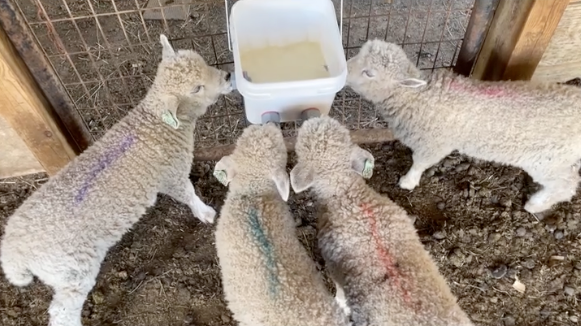May kicks off with the Maryland Sheep and Wool Festival the first weekend. While we are not taking sheep this year we will still be very involved with taking fleeces, supporting the Leicester Longwool display in the breed barn, and selling beer, fleeces, and hides in the farmers market. If you get to the Festival stop by and say ‘Hi.’
Lambing time has come – and gone! We have 18 lambs, 10 colored ones and 8 white ones bouncing and racing around. We ended up with 1 single, 1 set of triplets, lots of twins, and an amazing set of quadruplets. We have yet to find anyone who has had 4 lambs in this breed of sheep, so it is rare, but they are all doing fine. If you see them running around with pink, blue, purple, and red stripes on their backs it is so we can tell them apart!
We have set up the creep feeder for the lambs so they can begin eating grain. This is an enclosed area with adjustable openings so the lambs can get access to the grain, but the bigger sheep can’t. The lambs will get their first round of vaccinations at about 30 days old (mid-May). They are then given boosters 30 days later. (sound familiar?).
In addition to growing lambs May is the start of hay season. The fields have been fertilized and so far, growing weather has been good. Normally we do our first cutting around Memorial Day. Hay making is really a 4- step process. First the hay is cut. Then it is tedded or basically stirred about to help it dry. It then is raked into windrows so the baler can pick it up and bale it into either small square bales or bigger round bales. Watching the baling is a real treat. Who would think a machine could scoop up the hay, compact it, wrap it in string, tie the string, and (if small square bales), throw it into a wagon – without computers!
The hop yard really starts to come to life in May. This year we are very excited to be planting our own Monocacy hop plants. The ‘starts’ were overwintered in a protected area next to the barn and all have begun to reappear. We will transplant these into the main hop yard. The sheep will be moved out so the hops shoots can start to grow without being nibbled off. Poles will need to be straightened and cables tightened up. Tom will crown the rows to help control mildews. Stringing is then done by hand in May. This entails running coir twine from the ground where it is held in place with ‘hop clips’ over the trellis wires and back down. The coir twine is made from coconut fiber which provides a rough surface for the hops to grip and is also strong enough to withstand the hop picker.
Potatoes have been planted and sweet corn will go in after Mother’s Day.

